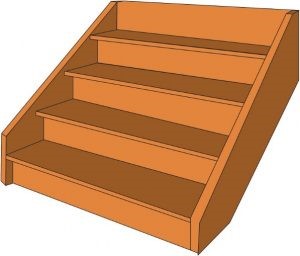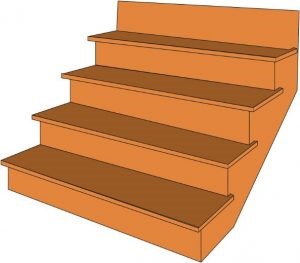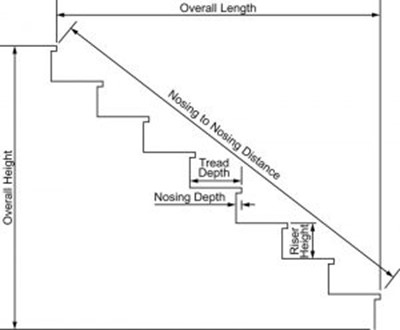5 Easy Steps to Measure Stair Railing
Whether you are purchasing individual components or an entire railing system, there are a few measurements that are needed to ensure a proper fit. Each set of stairs is unique. Ensuring you have the correct dimensions is the first step in properly specifying any railing system.
Let’s first review the key components of a set of stairs. Below are 13 commonly used terms when talking about stairs and are necessary to understand when taking measurements for handrail systems.
Commonly Used Terms
- Handrail—The handrail provides guidance and security. They are required by building codes and must meet load, height and graspability requirements.
- Newel Post—A newel is a vertical post placed at the top and bottom ends of flights that support the handrails. This type of post is also commonly referred to as a central pole or support column.
- Balusters or Spindles—These are vertical components used to fill the opening between the handrail and the bottom rail or treads. They provide strength, safety, and aesthetics.
- Balustrade—This term refers to the combined framework of handrails and balusters.
- Tread—The tread is the top, horizontal component of a step. It’s where you place your foot while using the stairs.
- Riser—This is the vertical member between two treads or the floor and the first tread. It provides support to the treads.
- Step—A step is the combination of the tread and riser. This assembly is what allows the ascent or descent from one floor to another.
- Rise—Not to be confused with the riser, the rise is the vertical distance between the surfaces of two consecutive steps.
- Flight—A flight is a continuous series of steps without any break or a landing. This is where the commonly used phrase "a flight of stairs" comes from.
- Landing—A landing is the term for the platform placed between two stair flights.
- Nosing—Nosing is the outer, often projecting edge of a tread.
- Winders—In the absence of a landing, these are tapering steps used for changing the direction of a stair.
- Stringers—A stringer is a sloped member of a stair that supports the steps. They may be closed or open.


Since each set of stairs and handrail application is unique, it's necessary measurements are accurate. When calculating measurements, take your time, and measure twice. Follow the five easy steps below to obtain the measurements necessary for your handrail system.
5 Easy Steps for Measuring
Step 1: Measure the overall height. The overall height is the distance from the floor or landing at the top of the set of stairs to the floor/landing at the bottom of the set of stairs.
Step 2: Measure the overall length. When determining the overall length, measure the horizontal distance from the edge of the nosing on the first tread at the bottom of the staircase to the edge of the nosing on the floor/landing at the top of the staircase.
Step 3: Length of nosing. To obtain the length of the nosing, measure the top edge of the nosing of the first tread to the top edge of the floor/landing nose. Do not confuse this measurement with the overall length.
Step 4: Depth of finished tread. To obtain this measurement, measure the length of one finished tread (from front to back).
Step 5: Height of finished tread. To obtain this measurement, measure the height of a riser from the base tread to the tread of the next stair above it.
It’s also important to note we will need the number of risers and the number of treads to determine a complete handrail system for your application. When counting the number of risers, include the riser from the bottom floor or landing to the first tread. Then count to the last tread to the floor or landing at the top of the set of stairs. When determining the number of treads, do not count the floors or landings, only the number of finished treads. Typically, you will have one more riser than you will have treads.
Information for Submitting a Quote
When submitting an RFQ to Wagner, be sure to supply all the above measurements. Additionally, we will need to know your tread material (wood, concrete, metal, stone, etc.), desired post type, and the finished spacing between your posts. Please also indicate if the set of stairs features any winders and if the stringers will be opened or closed.
Bear in mind if your installation is to meet building codes, there will be structural and dimensional requirements that must be met. Handrail height must be between 34-38”. Structurally, it must be able to withstand a concentrated load of 200 lb or a uniform load of 50 lb/ft. Graspability requirements will limit handrail dimensions.
While there are a handful of measurements required to determine the proper handrail system for your stairs, it doesn’t have to be a complicated process. The most important thing to remember is each set of stairs is unique and requires its own set of measurements. With the proper measurements, you can rest assured you will be installing a properly fitting, code-compliant handrail, providing safety and beauty to all who use it. For more information contact us.

